Colosseum Games Martyrs | Location | Opening Hours Tickets | Authorisations | Roman Forum
Games Martyrs Story Architecture | Games Gladiators | Martyrs
Story and Architecture of the Colosseum in Rome in Italy
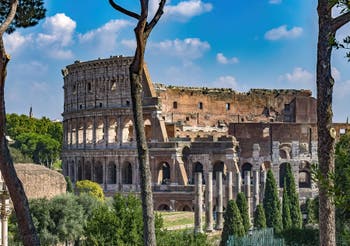
Colosseum Arena in Rome Grandiose, elegant, harmonious, the Colosseum is a 2,000-year-old colossus, it is the symbol par excellence of the greatness of ancient Rome, still admired by the whole world.
It was the Emperor Vespasian, of the Flavian dynasty immediate successors of Nero, who decided to build the Colosseum in the year AD 70.
He chose to build it on the site of an artificial lake that was part of the “Domus Aurea”, the “Golden House” of Nero, between the hills of Palatine, Esquilin and Coelius.
Its construction took 10 years of work involving several thousand Hebrew prisoners brought to Rome after the destruction of the Jerusalem Temple.
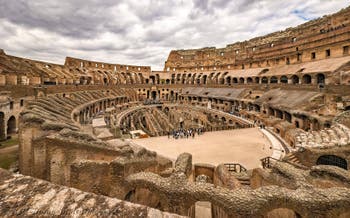
Colosseum Arena in Rome When it was inaugurated on April 21 of the year AD 80 by Titus, the son of Vespasian, it was called “The Flavian Amphitheatre” in honour of their dynasty: it was the true and only name used by the Romans at the time of the circus games.
Further work was then carried out by Emperor Domitian.
The Colosseum: 75,000 people and 50,000 seats
Circus games, gladiator fights, wild hunting, naval battles, etc. took place in the Colosseum for 400 years in a row, until the fifth century, when Christian emperors banned gladiator fights.This ancestor of our modern stadiums had 50,000 seats on marble covered bleachers, and, in its highest part, wooden stands allowed to accommodate 20,000 to 25,000 other spectators, sitting and standing.
The Impressive Dimensions of the Colosseum
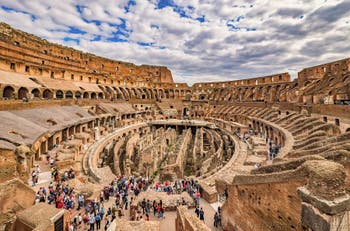
Colosseum Arena in Rome The circumference of the Colosseum is 545 metres, half a kilometre! And its height, originally 52 metres, is still today 48.5 metres.
The Colosseum is not round, it is an ellipse shaped.
The length axis of this ellipse is 188 metres long, while its width, the small axis of the ellipse, is 156 metres.
It took 100,000 cubic metres of travertine and 300 tons of iron for the attachment studs that unite the blocks for its construction.
The interior consisted of thousands of bricks and tuff blocks, fixed together by tons of cement as well as tons of marble.
The Colosseum, a Beautiful and Impressive Architecture
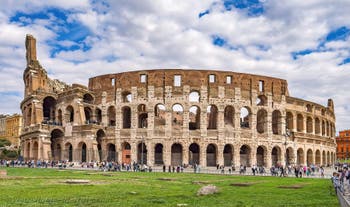
Colosseum Arena in Rome The Colosseum presents a perfect synthesis between the grandeur of its structure and the harmony of its forms, between elegance and simplicity.
Its facade consists of four floors.
The first three levels are composed of 80 arcades framed by half-columns.
These half-columns are Tuscan Doric style on the first floor, Ionic on the second floor, and Corinthian style on the third floor.
The fourth floor is without arcades, but it has a series of Corinthian style frames between which open windows.
The Colosseum, a Covered Stadium: The Velarium
The Colosseum could be covered with canvases, the “Velarium”, to protect spectators from the sun or rain.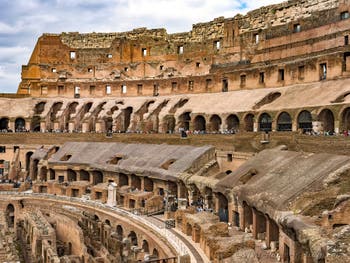
Colosseum Arena in Rome The canvas used to cover the Colosseum was made up of boat sails and weighed in total nearly 80 tons!
Handling such a canvas surface (186 metres for the longest axis of the ellipse) and such weight required perfect organization and execution.
This wreath of sliding boat sails was stretched over 240 pine masts located all around the Colosseum.
This immense canvas was stretched over the amphitheatre, with the help of pulleys and ropes tied to the 240 masts.
These manoeuvres were carried out by sailors from Capo Miseno's Imperial Roman Fleet who received special training before they could participate in this delicate and difficult operation.
A barracks had even been built for these sailors to house them for the duration of the games.
The Flavian Amphitheatre
In ancient times, in Rome and Greece, theatres were semicircular to allow everyone to be able to attend the performances as best as possible, with in addition to amplified acoustic qualities: no microphones or speakers at that time!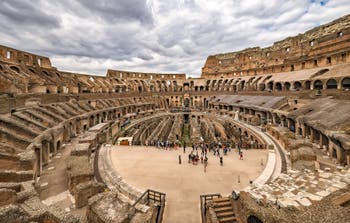
Colosseum Arena in Rome Amphitheatre means “double theatre”.
Two semicircular theatres were gathered to create a complete circle.
The first amphitheatres were made of wood, allowing, as needed, to use each theatre separately or to combine them into a single amphitheatre by rotating them on an axis.
The first stone amphitheatre was created during the reign of Emperor Augustus.
But the most famous of all was called the “Flavian Amphitheatre”, and it was the only name used by the Romans to designate the Colosseum at the time when the games were held there.
The Colosseum changes its name, the Colossus of Nero
In his madness of greatness, Emperor Nero (37-68 AD) had a colossal bronze statue of his person made by the Greek artist Zenodore.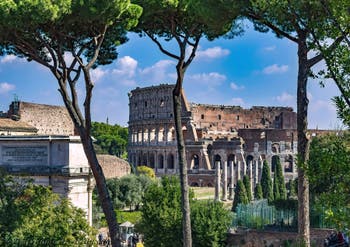
Colosseum Arena in Rome This statue, without its base, was 35 metres high: at that time it was the largest bronze statue in the world, higher than the famous Colossus of Rhodes from which it was inspired, as high as the Column of Trajan in Rome.
In the second century, it was decided to build a temple in Rome in honour of Venus.
However, the colossal statue of the former Emperor Nero was still on the land intended for the construction of the said temple. Instead of destroying it, it was decided to install it elsewhere.
Its weight was such that it was necessary to use 24 elephants in order to move it.
This is how she found herself installed right next to the Flavian Amphitheatre.
However, it was not permissible, given the horrors committed by Nero, to leave his statue as it is. It was thus transformed into a statue of Helios, the god of the sun, by altering the features of Nero's face and adjoining him a wreath of solar rays.
The Colosseum, new name of the Flavian Amphitheatre
Throughout the period during which games were held in the Colosseum, more than four hundred years, the only name known to the Romans to designate it was “the Flavian Amphitheatre” named after the dynasty of the emperor who built it.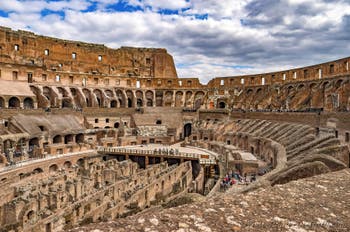
Colosseum Arena in Rome It was only in the Middle Ages, more precisely in the eighth century, that the name “Colyseus” appeared in a text written by an English monk named Beda Venerabilis.
He is the author of the famous prophecy:
« Quamdiu stabit Colyseus stabit and Roma; quamdiu cadet Colyseus cadet and Roma; quamdiu cadet Roma cadet et mundus. »
Beda Venerabilis (673-735)
That can be translated as:
« As long as the Colosseum exists, Rome will exist; when the Colosseum falls, Rome will fall; when Rome falls, the world will fall. »
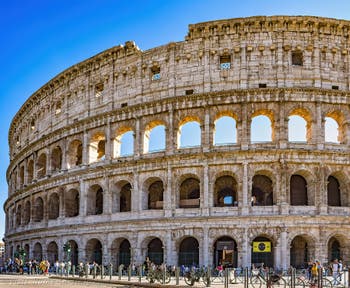
Colosseum Arena in Rome But it is not known whether the monk's prophecy referred to the colossal statue of Nero or the amphitheatre.
On the other hand, it is known that it was as a result of this prophecy that the Flavian amphitheatre was called “Colyseus”, Colosseo in Italian and Colosseum in English.
Nor is it known what became of the famous bronze colossus, probably melted to recover precious metal, perhaps to make them cannons, classical use of bronze.
It is assumed that the colossal bronze head of Emperor Constantine, which you can still admire at the Capitol Museum in Rome, may well be the famous head of Nero, whose features would have been modified to look like Constantine.
Social Classes at the Colosseum, Vomitorium and Cavea
Of the 80 arcades of the Colosseum, 76 were intended for the public.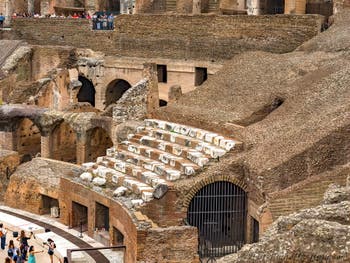
Colosseum Arena in Rome From these 76 arcades we accessed the walkway, from where we passed the stairs which, through 160 mouths, the “Vomitorium” led to the “cavea”, namely all the bleachers.
The other four arcades, each located at a cardinal point, were reserved for officials.
The two arcades located on the longest axis of the ellipse served as input and exit for religious processions that opened the games.
The arcade of the north entrance, flanked by pilasters, where there is now a cross, was reserved for the emperor and his suite.
The emperor arrived at the Colosseum through an underground passage that directly connected the amphitheatre to his palaces, which avoided him having to pass through the crowd.
Division of places of the Colosseum according to the Social Class
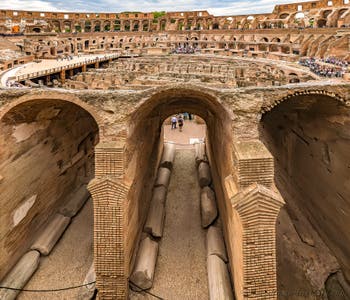
Colosseum Arena in Rome In the area of the cavea destined for the emperor, which was closed by balustrades, civil and religious authorities, including the Vestals, were seated.
Because of the presence of the emperor during the games, spectators were obliged to be dressed with dignity.
Wearing the toga was a rigour for Roman citizens.
Similarly, always out of respect for the emperor, it was forbidden to eat or drink during the course of the show. So one had to wait for lunch intermission.
Senators were entitled to the best seating positions on the lowest, closest to the arena.
The Order of Horsemen was on the stands immediately above those of the senators.
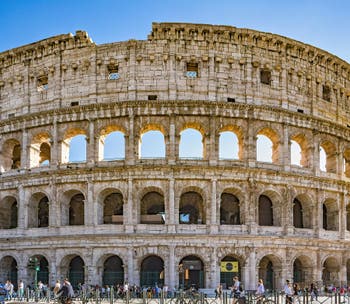
Colosseum Arena in Rome Still above them, male Roman citizens sat down, divided into subgroups, craftsmen, small traders, etc.
A third area, located above the previous ones, had wooden benches and was divided into two parts, one intended for the Romans, and the other for visitors who did not possess Roman citizenship.
This separation of women and men was not linked to social importance, but to reasons of safety. The crowd could warm up a little too much during these sometimes very violent fights and it was better for women to be away, to be protected from possible overflows.
It should be noted that in Roman society, especially evolved in this capacity, not only could women attend the shows, but could even participate in the fighting.
The slaves, who also had the right to attend the games, were on the fourth floor and stood.
Games Martyrs Story Architecture | Games Gladiators | Martyrs
Colosseum Games Martyrs | Location | Opening Hours Tickets | Authorisations | Roman Forum
Back to Top of Page

